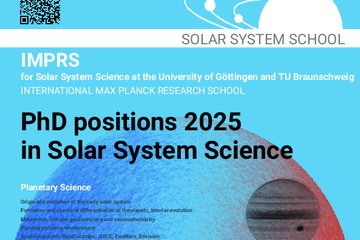All genres
81.
Journal Article
Measurements of the atmospheric water vapor on Mars by the Imager for Mars Pathfinder. Journal Geophysical Research 104, pp. 9019 - 9026 (1999)
82.
Journal Article
The shape of a sublimating ice surface at the bottom of a non-volatie cylinder: Monte Carlo simulations and 2-D analysis. Advances in Space Research 21, pp. 1599 - 1602 (1998)
83.
Journal Article
Evolution of ice surfaces within porous near-surface layers on cometary nuclei. Planetary and Space Science 46, pp. 357 - 366 (1998)
84.
Journal Article
Optical properties of morning-ice-haze and cloud particles and the photometry of Mars. Solar System Research 32 (6), pp. 469 - 479 (1998)
85.
Journal Article
Origin and dynamics of comets and star formation. Planetary and Space Science 45, pp. 1099 - 1104 (1997)
86.
Journal Article
Light scattering by nonspherical particles: A modification of the statistical model and application to the Martian aerosol. Solar System Res. 31, pp. 369 - 376 (1997)
87.
Journal Article
Observations of Martian aerosols with the Imager for Mars Pathfinder. Advances in Space Research 19, pp. 1271 - 1276 (1997)
88.
Journal Article
Properties of the Mars atmosphere: A revised analysis of Phobos/KRFM data. Planetary and Space Science 45, pp. 281 - 288 (1997)
89.
Journal Article
Ice, hazes, and clouds in the Martian atmosphere as derived from the PHOBOS/KRFM data. Planetary and Space Science 44, pp. 1163 - 1176 (1996)
90.
Journal Article
Collimation of cometary dust jets and filaments. Planetary and Space Science 42, pp. 367 - 382 (1994)
91.
Journal Article
Development of a dust mantle on the surface of an isolated ice-dust mixture: Initials results from KOSI-9 experiment. Journal Geophysical Research 98 (E8), pp. 15091 - 15104 (1993)
92.
Journal Article
CODAG - Dust agglomeration experiment in micro-gravity. Advances in Space Research 13 (7), pp. 73 - 76 (1993)
93.
Journal Article
Coagulation of interstellar grains in turbulent Pre-solar nebula: Models amd laboratory experiments. Rev. Mod. Astron. 6, pp. 149 - 163 (1993)
94.
Journal Article
KOSI? Geophysical Research Letters 18 (2), pp. 249 - 252 (1991)
95.
Journal Article
KOSI: Gas drag derived from ice/dust-particle trajectories. Geophysical Research Letters 18 (2), pp. 273 - 276 (1991)
96.
Journal Article
Turbulende induced relative velocity between two grains. Astronomy and Astrophysics 242, pp. 286 - 289 (1991)
97.
Journal Article
Diffuse particle acceleration in spherically symmetric shock waves: supernova remnant origin of cosmic rays. Astronomy and Astrophysics 236, pp. 487 - 502 (1990)
98.
Journal Article
Simplified models for the evolution of supernova remnants including particle acceleration. Astronomy and Astrophysics 225, pp. 179 - 191 (1989)
99.
Journal Article
Grain growth in turbulent protoplanetary accretion disks. Astronomy and Astrophysics 195, pp. 183 - 192 (1988)
100.
Journal Article
Dielectrophoretic, thermal instability in a spherical shell of fluid. Geophys. Astrophys. Fluid Dynamics 21, pp. 225 - 236 (1982)











